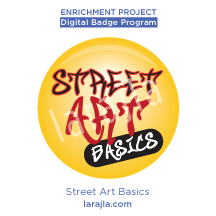Street art is becoming legal in many places worldwide. Street art can be bright and in your face or blend in with its surroundings. It can be an adjustment of materials that are available at your site, items you’ve created to leave or created on the spot. Your creativity determines what form your street art will take.
NOTE: If you’ve not experienced street art, start with “Street Art Explore.”
.
Steps
Before you create
1. Scouting.
Preplanning is your best bet with street art. Your street art will usually be temporary. Look for the following places to put street art.
- Temporary walls
- Shelves / tables you can leave items
- Empty planters / land
- Abandoned materials
- Places with many natural resources like parks and beaches
Note the locations you’d like to put your art or photograph the locations. If you use photography, be sure to include visual identifiers so you know where you took the picture.
2. Time of day.
A perfect location may not be accessible during certain times of the day. It might be too busy or used for another purpose. Watch the locations you have scouted and note times when you can place / create your art
3. Just keep moving.
Does the street art use a cultural voice? Does the design or story fit with the area it is placed? Does it interact with the community? If what you’re thinking of creating doesn’t fit with the area, keep moving until you find an area where it will work.
4. Start a conversation.
Find out what others think of the art you find. Do this with the people who live in the area and / or with people online. You may find reactions vary greatly with the two groups to the art.
Planning your moves
5. What do you want to say?
When you create art, you need a purpose. Determine what you want to say. Here are some broad ideas to help you start thinking.
- Tell a story
- Beautify an area
- Political opinion
- Make others aware of the environment
- Celebrate your culture
- Start a conversation with your community
- Make others aware of issues that concern you
Remember, your goal is to trigger an emotional response. If you are not passionate, it will show in your art. Track your ideas in your street art journal.
6. Brainstorm ideas.
Now that you have an idea of what you want to say, brainstorm ideas for how to say it. Keep a journal of your brainstorming sessions. You can use this for future ideas and inspiration.
7. Select your media.
Paint, chalk, stickers, stamping . . . the way you create your art is personal. You might choose to recycle broken items into art. You might choose to use natural items in a non-natural setting. Remember, something as simple as seed bombing can be a statement.
8. Make an artist kit.
Small items you will need are easy to place into a container to take with you “just in case.” As you work on your own art, think about what you have around your home to incorporate. Tape, pens, markers, chalk, Post-It notes . . . all items you might find you need once you get on site. Plan ahead!
Creating your art
9. Drop off art.
You may not want to start by creating art while others watch. You can create art at home and merely place it where you’d like it. Painted rocks, doodle journals, signs and endless other items can be prepared ahead of time. Scout locations where you can place your art. If you want it to be interactive, give just enough information within your art for someone to take action, but not enough to dictate what they should do.
10. Create your art.
Remember, a sticker with a simple word can be as effective as a huge mural on the side of a building. You might want to put stamped animal prints on the sidewalk to visualize our disappearing wildlife. Even a chalk drawing can draw your community in. Your art can be complicated to stop people who are walking by or very simple with a one colored stencil. Explore various techniques and ways to create street art on-site.
11. Performance art.
Perhaps you prefer performance art instead of leaving something behind. You can do something loud and crazy like a flash mob or play a few songs on your guitar during lunch time. You can mime or do magic tricks. Your performance is up to you.
12. Green graffiti.
Try expanding your street art by incorporating plants, seed bombs or moss graffiti. It may be as simple as planting flowers in an empty tract of land. You can create planters and put plants where they wouldn’t normally grow like chain link fences.
13. Using what’s available.
Stacking found items like rocks can change a haphazard scene to art. Decorating a discarded piece of furniture can change an eyesore into something beautiful. Examine what is around you to see if you can adjust what is available into something eyecatching.
14. Temporary.
Most street art is not permanent. Even painted walls fade or can be painted over. Think about documenting your street art through photos, audio or video. You may wish to add these into other artistic endeavors or just track your journey as an artist.
15. Observe.
Watch to see how people interact with your street art. How long do they stop? Do they even notice? If you are participating in your art? Ask someone to document or note what occurs for you to review later.
Supplements Available
Sites to Explore
- www.flickr.com/groups/startstreet_art
- www.ehow.com/how_2122339_do-street-art.html
- guerilla-art.wikidot.com/what-is-guerilla-art
- www.kerismith.com/popular-posts/how-to-be-a-guerilla-artist-2
- weburbanist.com/2009/06/14/20-subversive-works-of-urban-guerrilla-street-art
- abduzeedo.com/create-wheatpaste-poster
- streetcouch.com/moss-graffiti
- www.environmentalgraffiti.com/featured/moss-grass-graffiti/2147
- www.radicalmontreal.com/2012/03/sustainable-street-art.html
- www.clothpaperscissors.com/blogs/clothpaperscissorstoday/archive/2010/07/14/how-to-secretly-give-art-away.aspx
- www.complex.com/art-design/2013/01/how-to-make-it-10-rules-for-success-from-street-artists/#galleryS
- vimural.hubpages.com/hub/Introduction-to-Street-Art-A-Beginners-Guide
To download a PDF of this badge program, click here: EP_Street Art Basics

Leave a Reply